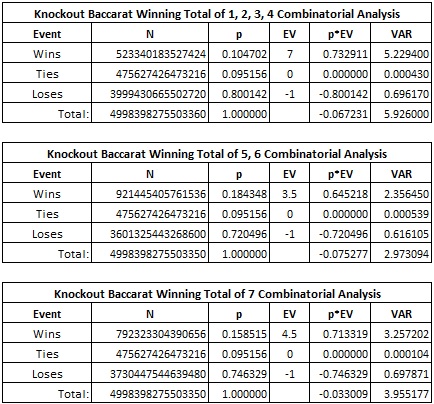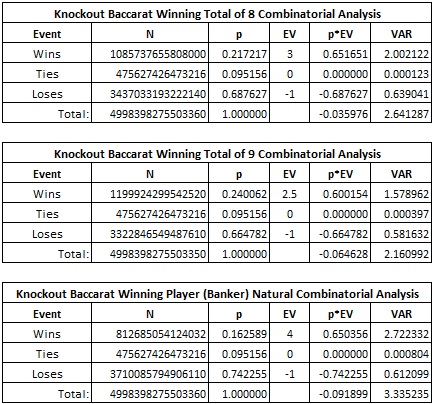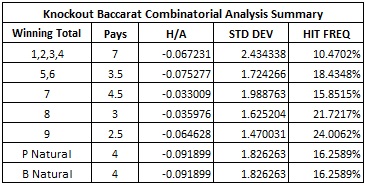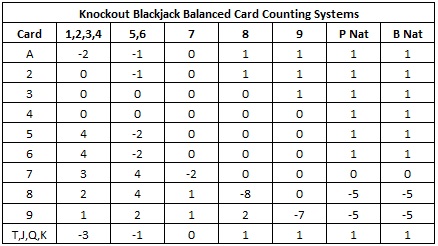Baccarat side bets that consist of a group of related wagers have a history of big game protection problems. A team of card counters targets the side bet by dividing up the individual wagers among their group. When a team member wagers on his particular side bet, the rest of the team follows by betting on the same side bet. In this way, each member of the team gets the full effect as-if they were counting every side bet on the layout. This "co-card counting" team approach has been applied, for example, to the UR Way Egalite baccarat side bet.
Knockout Baccarat (KOB) is a variant of baccarat that offers a collection of seven (7) separate baccarat side bets. These side bets are described as follows.
- Winning total of 1, 2, 3, 4. This side bet wins if the winning hand (Player or Banker) has a total of 1, 2, 3 or 4. This side bet is a push if the result of the hand is a Tie. Otherwise this side bet loses. A winning hand pays 7-to-1.
- Winning total of 5, 6. This side bet wins if the winning hand (Player or Banker) has a total of 5 or 6. This side bet is a push if the result of the hand is a Tie. Otherwise this side bet loses. A winning hand pays 3.5-to-1.
- Winning total of 7. This side bet wins if the winning hand (Player or Banker) has a total of 7. This side bet is a push if the result of the hand is a Tie. Otherwise this side bet loses. A winning hand pays 4.5-to-1.
- Winning total of 8. This side bet wins if the winning hand (Player or Banker) has a total of 8. This side bet is a push if the result of the hand is a Tie. Otherwise this side bet loses. A winning hand pays 3-to-1.
- Winning total of 9. This side bet wins if the winning hand (Player or Banker) has a total of 9. This side bet is a push if the result of the hand is a Tie. Otherwise this side bet loses. A winning hand pays 2.5-to-1.
- Player Natural. This side bet wins if the winning hand is a Player natural two-card 8 or 9. This side bet is a push if the result of the hand is a Tie (regardless of naturals). Otherwise this side bet loses. A winning hand pays 4-to-1.
- Banker Natural. This side bet wins if the winning hand is a Banker natural 8 or 9. This side bet is a push if the result of the hand is a Tie (regardless of naturals). Otherwise this side bet loses. A winning hand pays 4-to-1.
It is worthwhile explaining the "Tie is a push" rule. In order to make my house edge results match those in the available documentation, I had to interpret this rule in the most literal sense.
For example, if the player wagers on "winning total of 1, 2, 3, 4" and the hand ends in a 9-9 natural Tie, then the "winning total of 1, 2, 3, 4" wager is a push. In other words, the final total does not matter when the hand is a push.
The matter of a pushed hand is even more counter intuitive in the case of the Natural side bets. For example, if the player wagers on the Banker Natural side bet and the hand ends in a three-card 2-2 Tie, then the Banker Natural wager is a push.
I verified this non-intuitive interpretation of a push with the company that offers the game (INAG). I note that the results presented by Stephen How in his blog post at discountgambling.net assume that a Tie is a loss and not a push. Stephen's conclusions about advantage play are quite different from mine.
The following tables give the combinatorial analysis for each wager described above:


The following table summarizes the combinatorial analysis, along with giving the standard deviation and hit frequency for each wager described above:

I used the standard methodology to derive card counting systems for each wager. For each side bet, I computed the Effect of Removal (EOR) for each card. I then designed a card counting system to match the EORs as closely as possible while keeping the system human-feasible. Keeping in mind that players can use a score card in baccarat, the card counting systems can be more complex than in games like blackjack where the count must be calculated mentally.
The following table gives a card counting system for each KOB side bet:

For each of the seven KOB side bets, I ran a simulation of card counting consisting of one hundred million (100,000,000) eight-deck shoes using the system given in the previous table. I assumed that the cut card was placed at 14 cards and that the usual burn card rule was used.
The following table summarizes the results from these simulations:

As is clear from this table, there are a number of vulnerable side bets in this collection. For example, a three person team co-counting the "1,2,3,4", "7" and "8" side bets can win a total of about 8.52 units per 100 hands.
While the win-rate against KOB is not at the level of the UR Way Egalite collection of side bets, the variance is also much lower. These side bets will certainly get some attention if the table maximums are high enough.
The easiest way to solve the card counting issue for KOB is to simply change the payouts for the most vulnerable wagers. For example:
- Reduce the payout for "Winning total of 1,2,3,4" to 6-to-1 (house edge = -0.1719, units per 100 hands = 0.260).
- Reduce the payout for "Winning total of 5,6" to 3-to-1 (house edge = -0.1675, units per 100 hands = 0.069).
- Reduce the payout for "Winning total of 7" to 4-to-1 (house edge = -0.1123, units per 100 hands = 0.216).
- Reduce the payout for "Winning total of 8" to 2.5.-to-1 (house edge = -0.1446, units per 100 hands = 0.080).
- Reduce the payout for "Winning total of 9" to 2-to-1 (house edge = -0.1847, units per 100 hands = 0.020).
I recommend that any casino that offers the KOB collection of side bets with full payouts be aware of the possibility of a team approach to card counting.


